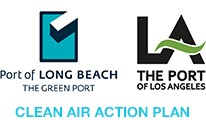The Port of Long Beach and the Port of Los Angeles held a public workshop on the Clean Air Action Plan (CAAP) on Wednesday, Oct. 14, 2015, discussing achievements of the plan to date, including emissions reductions, and plans for the future. Initially adopted in 2006 and updated in 2010, this historic environmental plan called for aggressive strategies that have proved highly effective in reducing air pollution from port-related sources.
 Since its adoption, the CAAP has resulted in unprecedented reductions in air pollution from the ships, trains, trucks, terminal equipment and harbor craft that operate in and around the ports. Over the past decade, levels of diesel particulate matter have dropped 82 percent, oxides of nitrogen fell 54 percent and oxides of sulfur have declined 90 percent due largely to pollution-reducing strategies implemented under the plan.
Since its adoption, the CAAP has resulted in unprecedented reductions in air pollution from the ships, trains, trucks, terminal equipment and harbor craft that operate in and around the ports. Over the past decade, levels of diesel particulate matter have dropped 82 percent, oxides of nitrogen fell 54 percent and oxides of sulfur have declined 90 percent due largely to pollution-reducing strategies implemented under the plan.
The Ports envisioned the CAAP as a “living document,” and have periodically reviewed and updated it. In recent months, the ports have started gathering input from multiple stakeholders. The workshop will include a presentation outlining the scope and timeline of the next update of the CAAP, as well as an interactive dialogue with attendees.
The Port of Los Angeles and Port of Long Beach are the two busiest ports in the nation, first and second respectively, and combined are the 10th busiest port complex in the world. The two ports handle approximately 40 percent of the nation’s total containerized imports and 25 percent of its total exports. Trade that flows through the San Pedro Bay ports complex generates more than 3 million jobs nationwide.
Download the presentation from the workshop here.
Comments from the workshop are now online; download them here.
Send additional comments to caap@cleanairactionplan.org.
